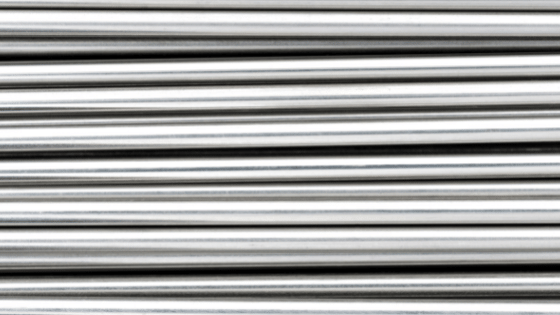Kloeckner Metals proudly supplies stainless steel bar in a variety of grades and finishes nationwide across our network of 40+ branches.

T-303 bar offers outstanding machinability and is almost exclusively used for machined parts, mostly in automatic screw machines. While T-303 is not hardenable by heat treatment, it can be cold worked to increase strength and hardness. It is not considered very weldable.
304 is the most popular stainless steel, boasting high strength, good corrosion resistance, excellent formability, and good welding characteristics. This grade is found in aerospace and automotive components, architectural fixtures, kitchen sinks, consumer durables, and food processing equipment.
The ultra-low carbon variant of 304 stainless, 304L is more resistant to intergranular corrosion than 304, especially during welding.
316L is the ultra-low carbon variant of 316 stainless steel. The main difference from 304L in chemical composition is the addition of molybdenum which enhances corrosion resistance and mechanical properties at higher temperatures. Some industries applying this stainless grade include the chemical, fertilizer, and pharmaceutical industries. It is also used for marine applications, and aircraft and architectural components.
T-303 bar offers outstanding machinability and is almost exclusively used for machined parts, mostly in automatic screw machines. While T-303 is not hardenable by heat treatment, it can be cold worked to increase strength and hardness. It is not considered very weldable.
304 is the most popular stainless steel, boasting high strength, good corrosion resistance, excellent formability, and good welding characteristics. This grade is found in aerospace and automotive components, architectural fixtures, kitchen sinks, consumer durables, and food processing equipment.
The ultra-low carbon variant of 304 stainless, 304L is more resistant to intergranular corrosion than 304, especially during welding.
316L is the ultra-low carbon variant of 316 stainless steel. The main difference from 304L in chemical composition is the addition of molybdenum which enhances corrosion resistance and mechanical properties at higher temperatures. Some industries applying this stainless grade include the chemical, fertilizer, and pharmaceutical industries. It is also used for marine applications, and aircraft and architectural components.

Stainless steel bar is available in the alloy grades T-303, 304, 304L, and 316L in the cold drawn, centerless ground, hot, and mill finishes. It is frequently used in the automotive, aerospace, food service, chemical, and marine industries, among others.
ANSWER:
Stainless steel bar is a stainless steel product primarily used in industrial applications. Kloeckner Metals supplies it in various grades and finishes.
ANSWER:
It can be used in components seen across industries and is especially suitable for applications requiring superior corrosion resistance and machinability. Pulp, paper, and dyeing equipment, heat exchangers, and film processing equipment are all typical end uses for this stainless steel grade.
ANSWER:
316L stainless is an ultra-low carbon variant which means that the maximum carbon content permitted is set at 0.03%, whereas other stainless steel grades may contain up to 0.08% carbon. 316L has the addition of molybdenum for superior performance including increased corrosion resistance and improved mechanical properties at elevated temperatures.
ANSWER:
Stainless steel bar is a stainless steel product primarily used in industrial applications. Kloeckner Metals supplies it in various grades and finishes.
ANSWER:
It can be used in components seen across industries and is especially suitable for applications requiring superior corrosion resistance and machinability. Pulp, paper, and dyeing equipment, heat exchangers, and film processing equipment are all typical end uses for this stainless steel grade.
ANSWER:
316L stainless is an ultra-low carbon variant which means that the maximum carbon content permitted is set at 0.03%, whereas other stainless steel grades may contain up to 0.08% carbon. 316L has the addition of molybdenum for superior performance including increased corrosion resistance and improved mechanical properties at elevated temperatures.

X
The Kloeckner Metals website uses modern technologies. Unfortunately, your browser doesn't support those technologies.
Download the latest version of one of these browsers to experience the site: